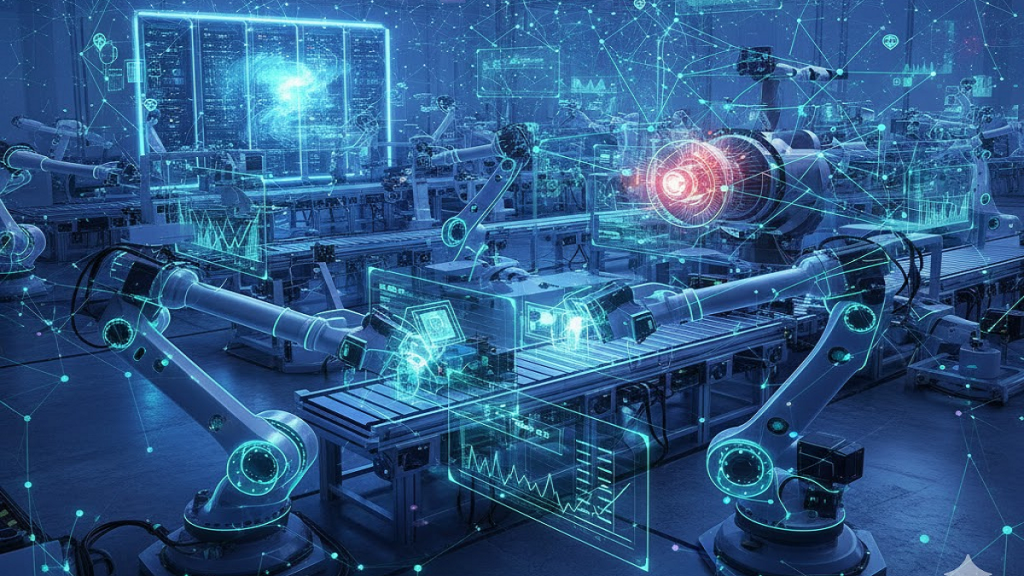Smart Sensors: The Eyes and Ears of Next-Generation Manufacturing
Imagine a factory where machines sense minute vibrations that precede failure, where every part is inspected the moment it’s made, and where production lines adjust themselves automatically for optimal performance. This is not a distant vision of Industry 4.0; it’s the new reality made possible by smart sensors, the silent yet indispensable foundation of digital manufacturing.
The global manufacturing landscape is being reshaped by the convergence of information technology (IT) and operational technology (OT). This ongoing industrial transformation, often referred to as the Fourth Industrial Revolution, is moving production toward intelligent, connected, and autonomous systems. At the heart of this change are sensors – devices that have evolved from simple measurement tools into intelligent nodes that sense, process, and communicate.
Smart sensors form the nervous system of modern factories, transforming data into insight and insight into action. Their integration across machines, processes, and supply chains is not a mere technological upgrade – it’s the cornerstone of next-generation manufacturing, unlocking new levels of productivity, quality, and sustainability.
From Traditional to Smart Sensing: A Quiet Revolution
For decades, industrial sensors served a narrow purpose: to detect and report a physical parameter. A thermocouple read temperature, a pressure gauge tracked force, and a vibration sensor signaled imbalance. These conventional sensors were typically analog, providing single-point readings that required external systems for data acquisition and analysis.
By contrast, smart sensors integrate three essential components:
Sensing Element – that measures a physical property—temperature, vibration, strain, pressure, or light.
Embedded microprocessor or microcontroller – for on-board signal conditioning, data processing, and self-diagnostics.
Digital communication interface – wired or wireless that connects directly to control systems, edge devices, or cloud platforms.
This integration gives smart sensors the power to process and filter data locally (edge computing), perform self-calibration, and even self-diagnose drift or malfunction. Instead of transmitting raw, noisy data, they send meaningful, actionable information. The result is a leaner, faster, and more reliable flow of intelligence across manufacturing operations.
Smart sensors represent a paradigm shift – from passive data collection to active, context-aware participation in process control.
The Foundation of Industry 4.0: The Sensor-Driven Ecosystem
 Industry 4.0 envisions the factory as a cyber-physical system (CPS), where the physical world of machines and materials is tightly interwoven with the digital world of analytics and automation. Smart sensors are the critical bridge connecting these two domains.
Industry 4.0 envisions the factory as a cyber-physical system (CPS), where the physical world of machines and materials is tightly interwoven with the digital world of analytics and automation. Smart sensors are the critical bridge connecting these two domains.
Real-Time Data Acquisition
High-resolution, real-time data from smart sensors provides visibility into every aspect of production—from spindle vibration and machine temperature to part geometry and environmental conditions. This continuous feedback loop allows immediate detection of deviations and enables dynamic process adjustments that maintain quality and efficiency.
The Industrial Internet of Things (IIoT)
Equipped with IP addresses or wireless communication modules, smart sensors create a distributed, connected network of intelligent devices. This Industrial Internet of Things (IIoT) enables equipment across entire facilities—and even across continents—to share data seamlessly. Wireless sensor networks (WSNs) simplify installation in complex environments and extend monitoring into areas that were once inaccessible.
Edge Computing Integration
In a world generating terabytes of factory data daily, sending all information to the cloud for processing is inefficient. Smart sensors equipped with edge intelligence can process signals locally—detecting anomalies or triggering alerts in milliseconds. A vibration sensor, for instance, can identify bearing wear patterns and send only a health score or alert, not a continuous data stream. This reduces latency, conserves bandwidth, and empowers real-time decision-making on the shop floor.
Transforming Manufacturing’s Core Pillars
The impact of smart sensing technology extends across every domain of modern manufacturing—from asset management to process optimization and supply chain visibility.
Predictive Maintenance: From Reaction to Prediction
Maintenance strategies have evolved from reactive (“fix it when it breaks”) to preventive (scheduled checks) and now to predictive where data determines exactly when service is needed.
Smart sensors enable this shift by continuously monitoring equipment health:
- Vibration and acoustic sensors detect subtle frequency changes that signal wear or misalignment.
- Temperature and current sensors reveal friction, overloads, or early-stage failures.
By identifying issues before breakdowns occur, predictive maintenance can reduce unplanned downtime by up to 30% and cut maintenance costs by 10%, while extending asset life and optimizing production scheduling.
Process Optimization and Real-Time Quality Assurance
In high-precision manufacturing, the difference between acceptable and defective is measured in microns. Smart sensors play a vital role in keeping production within tolerance.
- Optical, laser, and vision sensors perform 100% in-line inspection, measuring parts and assemblies in real time with micron-level accuracy. They enable closed-loop control, where detected deviations trigger immediate corrections.
- Environmental sensors monitor humidity, temperature in industries such as semiconductors, aerospace, and pharmaceuticals, ensuring strict compliance with process conditions.
- Feedback integration ensures that sensor data flows directly into process control systems – automatically adjusting flow rates, tool speeds, or material feed to maintain stability.
This move from post-process inspection to continuous, in-process verification redefines metrology’s role in manufacturing. Measurement becomes proactive, preventing errors instead of detecting them after the fact.
Deep Intelligence: When Smart Sensors Meet AI
The next frontier of sensor technology lies in its synergy with Artificial Intelligence (AI) and Machine Learning (ML). As sensors generate ever-richer datasets, AI transforms that information into foresight and autonomy.
AI-Powered Anomaly Detection: Machine learning algorithms trained on normal operating patterns can detect even the slightest deviations—long before a human operator or threshold-based alarm would notice. These systems can identify anomalies across thousands of sensors simultaneously, providing an early-warning system for both quality and equipment health.
Digital Twins: Smart sensors feed real-time data into digital twins—virtual models of machines, production lines, or entire factories. Engineers can simulate adjustments, test process changes, and predict outcomes without disrupting production. The digital twin evolves continuously, reflecting the live state of its physical counterpart.
Autonomous Optimization: As AI matures, it will increasingly close the loop between sensing and control. Future production systems will self-optimize—adjusting parameters, tool paths, or process sequences in real time based on sensor feedback. These adaptive manufacturing systems will deliver unparalleled flexibility and efficiency, essential for mass customization and rapid design cycles.
The Metrology Connection: Sensing Quality at the Source
For the metrology community, the rise of smart sensors represents a profound shift. Quality assurance is no longer confined to the coordinate measuring machine or post-process inspection cell. Instead, metrology is migrating into the production line, embedded directly into tools, fixtures, and robotic systems.
Inline and nearline measurements powered by smart sensors enable real-time verification of critical dimensions and process parameters. This not only reduces scrap and rework but also creates a continuous digital record of quality data—essential for traceability, compliance, and closed-loop manufacturing.
In essence, smart sensing transforms metrology from a validation function into a continuous intelligence system, ensuring quality is built into the process rather than checked at the end.
Smart sensors are the enablers of the modern digital enterprise. By turning machines into intelligent, communicative assets, they bridge the gap between the physical and digital worlds.
Manufacturing Becomes Smarter
The factories of the future will be self-aware ecosystems – monitoring themselves, learning from data, and adapting to change with minimal human intervention. They will not simply detect problems but anticipate them; not merely execute instructions but optimize themselves in real time.
For manufacturers striving for competitive advantage, the path forward is clear: the strategic integration of smart sensing technologies is no longer optional. It is the key to achieving agility, resilience, and sustainability in an era defined by data-driven intelligence.
Smart sensors are not just the eyes and ears of Industry 4.0 – they are its heartbeat.
Author: Gerald Jones Editorial Assistant








